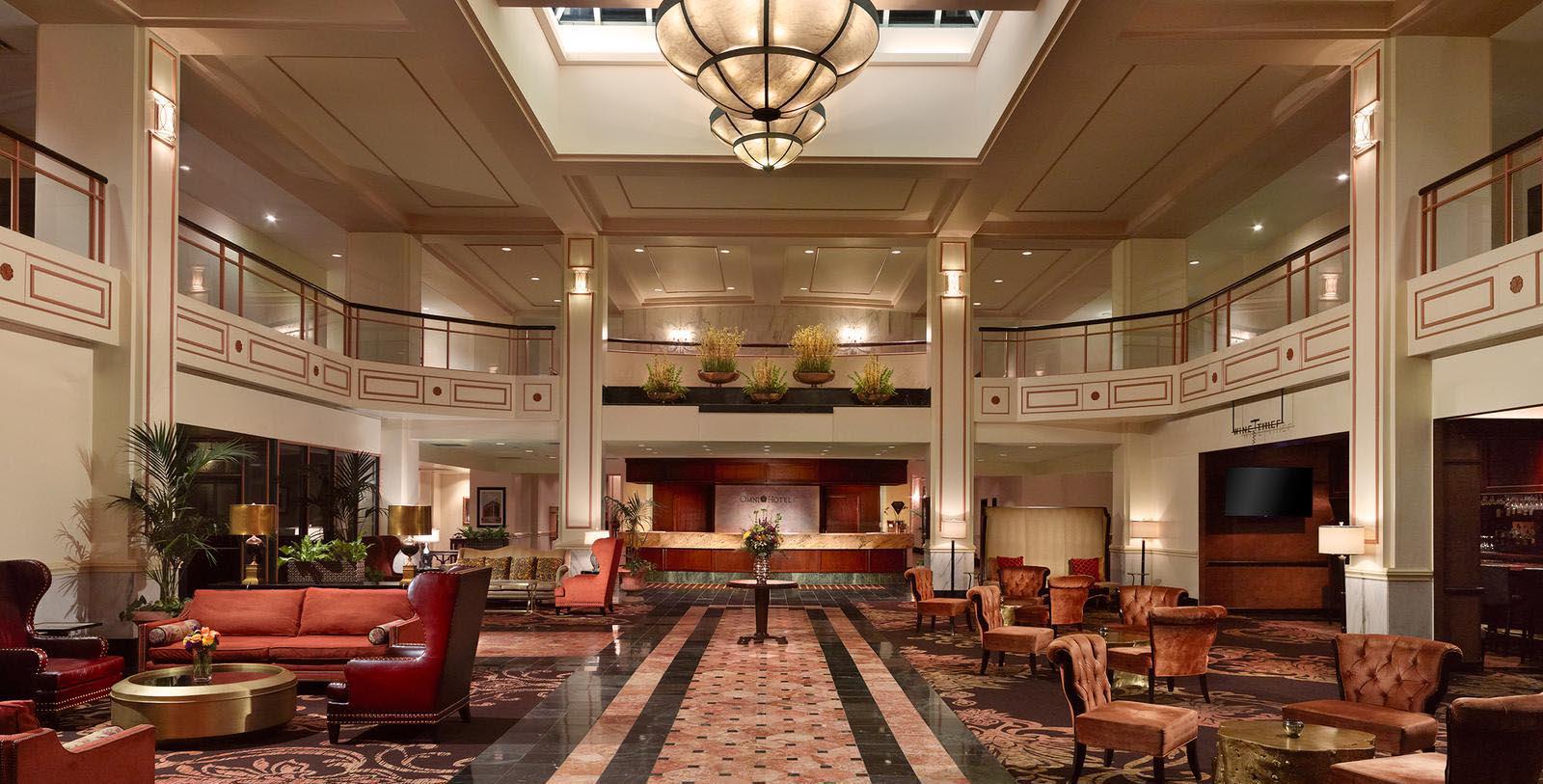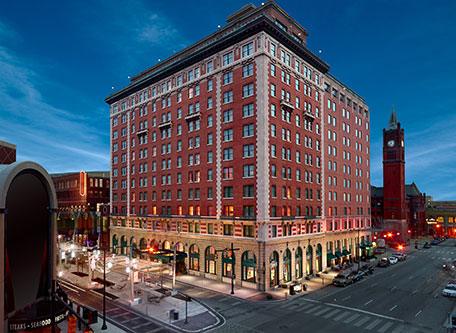Receive for Free - Discover & Explore eNewsletter monthly with advance notice of special offers, packages, and insider savings from 10% - 30% off Best Available Rates at selected hotels.
history
Discover the Omni Severin Hotel Indianapolis with its dramatic and stunning interior flourishes such as an Austrian crystal chandelier and a marble staircase.
Omni Severin Hotel, Indianapolis, a member of Historic Hotels of America since 2010, dates back to 1913.
VIEW TIMELINE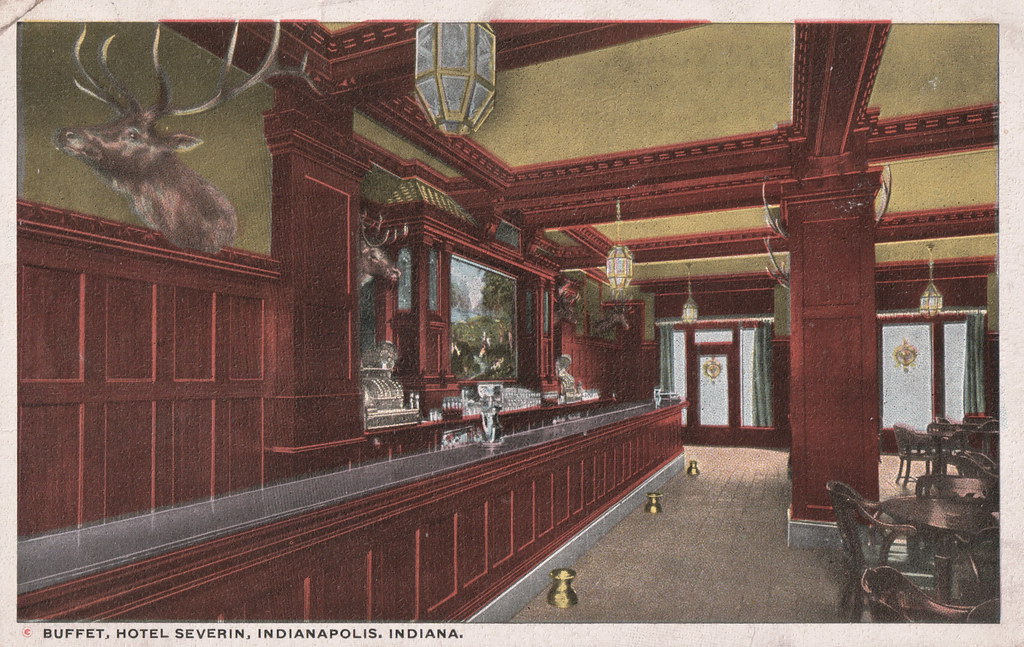
Omni Severin Hotel Indianapolis 100 Year Celebration
Ideally located in the heart of downtown Indianapolis, the Omni Severin Hotel stands as the city's longest running luxury hotel and is a beautifully restored piece of the city's history. This luxury Indianapolis hotel elegantly combines the grandeur of the early 1900's with the modern amenities and superior service of today.
WATCH NOWThe Omni Severin Hotel first appeared at the dawn of the 20th century, in which the United States had begun its emergence as a global superpower. Henry Severin Jr., heir to a massive grocery store empire, was the mastermind behind its development, for he longed to own a brilliant hotel that would cater to the city’s most exclusive clientele. Hiring local architectural firm Vonnegut and Bohn, Severin built his magnificent structure on the site of an old hotel known as the “Grand Hotel of Indianapolis.” The Grand Hotel had actually occupied the plot of land since 1876, as part of a greater business strategy to attract customers arriving at the nearby Union Railway Station. Yet, a massive fire had erupted around the Grand Hotel in 1905, which destroyed most of the surrounding buildings and suppressed interest in traveling to the area. Vowing to restore the neighborhood back to its former glory, Severin purchased the Grand Hotel and tore it down in order to construct what he hoped would be a magnificent Grand Dame.
To finance the project, Severin sought help from two prominent local businessmen: Carl G. Fisher and James A. Allison. While the two men were responsible for creating dozens of businesses throughout Indianapolis, their most noteworthy achievement was the development of the Indianapolis Motor Speedway in 1909. Severin hired the local architecture firm Vonnegut & Bohn to create the building’s appearance. The lead architect was Kurt Vonnegut, Sr., father of the renowned American author Kurt Vonnegut Jr. What Vonnegut and Bohn achieved was nothing short of spectacular. When the hotel finally debuted as the “Hotel Severin” in 1913, its façade stood as a brilliant example of Beaux-Arts-style architecture. Measuring 12 stories in height, the Vonnegut & Bohn used a reinforced concreate frame with 12-inch-thick red brick to create the exterior. Inside the first two floors, guests would encounter design aesthetics inspired by the principles of Renaissance Revival architectural forms. The roof was even planned to accommodate a banquet hall, as well as a fantastic penthouse suite.
When demand for passenger trains declined in the mid-20th century, so too did the business at the Severin Hotel. As such, several, different owners managed the hotel until it was purchased by Warren M. Atkinson in 1966. Atkinson subsequently rebranded the building as the “Atkinson Hotel,” which subsequently operated under the name for the next couple of decades. He then proceeded to invest some $2.5 million into renovating the hotel. But Atkinson would eventually sell his stake in the business during the late 1980s, transferring his ownership rights over the Mansur Development Corporation. The company formed a partnership with Omni Hotels and Resorts and changed the building’s name to the “Omni Severin Hotel.” In concert with Omni Hotels and Resorts, the Mansur Development Corporation then began an extensive $40 million renovation that sought to revitalize the historical elegance of the location. Now a member of Historic Hotels of America—and its sibling program, Historic Hotels Worldwide—the Omni Severin Hotel remains one of Indianapolis’ most celebrated cultural landmarks.
-
About the Location +
Listed on the National Register of Historic Places, the Indianapolis—Union Station Wholesale Historic District features the largest collection of Gilded Age buildings in Indianapolis. The Omni Severin Hotel is located in the heart of this fascinating neighborhood and has been identified by the U.S. Secretary of the Interior as one of its most significant structures. The modern nucleus of the district originates to the mid-1860s when the first recognizable commercial buildings appeared in the area. Most of these structures were characterized by their cast-iron facades and far-reaching vertical storage space. The most historic building left standing from this time period is a series of structures at the 200 block of South Meridian, which was originally occupied by the Byram, Cornelius & Company. Other buildings showcased a spectacular assortment of Italianate and Romanesque-themed architecture, such as the House of Crane and the D.P. Erwin and Company Building, respectively. Other architectural forms appeared, nonetheless, such as the Beaux-Arts-style Hotel Severin.
Many local merchants operated inside a majority of the structures, which created a uniquely vibrant marketplace that few other midwestern cities possessed. Farmers could even offer their produce and livestock for a cut of the action at a place called “Commission Row.” The debut of the Union Railway Station in 1888 further spurred the local economic activity, giving birth to a vibrant wholesale industry that played a significant role in Indianapolis’ economy for the next several decades. Everything from cigars to groceries could easily be found in the neighborhood, as gorgeously designed storefronts and warehouses quickly defined the skyline. Hundreds of railcars arrived at the building every day, introducing an unprecedented number of people and products. The traffic had become so great that by the dawn of the Roaring Twenties, Indianapolis sported on the largest rail networks in the United States.
This renaissance in local transportation diminished greatly though shortly after World War II, as demand for both freight and passenger trains declined. Despite efforts to revitalize the district’s economic health, the wholesale district entered a prolonged period of decay. Fortunately, many local entrepreneurs seized the initiative toward the end of the 20th century by establishing businesses that did not require direct access to the train station. Dozens of new restaurants and boutique storefronts opened shop in many of the area’s surviving Gilded-Age structures. The economic revolution was headlined by the relaunch of the Hotel Severin in 1988, when it became the “Omni Severin Hotel.” Visitors today can still see some of the historic buildings that once gave the neighborhood its rich cultural identity, such as the Union Railway Station. Perhaps the greatest example of Romanesque Revival-style architecture in the district today, the building is a great reminder of how the railroads worked with local businesspeople to create one of the most lucrative wholesale industries in American history.
-
About the Architecture +
To construct the Omni Severin Hotel, Henry Severin, Jr., sought out the services of a local architectural firm called Vonnegut & Bohn. The firm was originally founded by Bernard Vonnegut toward the end of the 19th century. Upon his death, control of the business passed to his son, Kurt Vonnegut, Sr., who was the father of renowned American author Kurt Vonnegut Jr. When the hotel finally debuted as the “Hotel Severin” in 1913, its façade stood as a brilliant example of Beaux-Arts-style architecture. Measuring 12 stories in height, Vonnegut raised the building with a reinforced concreate frame of 12-inch-thick brick curtain walls. Inside the first two floors, guests would encounter design aesthetics inspired by the principles of Renaissance Revival architecture. They featured monumental Roman arched windows set within a rusticated stone enframement. The hotel’s wonderful interior lobby—known today as the Severin Ballroom—possessed a stunning Austrian chandelier, as well as a marvelous marble staircase. Further up in the hotel, a broken banding of stone distinguished the 3rd floor, while stone quoins accents defined the 4th through 11th levels. The 12th story had its own unique festooned stringcourse that was defined by carved lion heads and a copper-crested cornice of acanthus leaves. The roof was even planned to accommodate a banquet hall, as well as a fantastic penthouse suite.
Beaux-Arts architecture itself originally began at the École des Beaux-Arts during the 1830s. There was much resistance to the Neoclassism of the day among French artists, who yearned for the intellectual freedom to pursue less rigid design aesthetics. Four instructors in particular were responsible for establishing the movement: Joseph-Louis Duc, Félix Duban, Henri Labrouste, and Léon Vaudoyer. The training that these instructors created involved fusing architectural elements from several earlier styles, including Imperial Roman, Italian Renaissance, ad Baroque. As such, a typical building created with Beaux-Arts-inspired designs would feature a rusticated first story, followed by several more simplistic ones. A flat roof would then top the structure. Symmetry became the defining character, with every building’s layout featuring such elements like balustrades, pilasters, and cartouches. Sculptures and other carvings were commonplace throughout the design, too. Beaux-Arts only found a receptive audience in France and the United States though, as most other Western architects at the time gravitated toward British design principles.
Renaissance Revival architecture, on the other hand, is a group of architecture revival styles that date back to the 19th century. Neither Grecian nor Gothic in their appearance, Renaissance Revival-style architecture drew inspiration from a wide range of structural motifs found throughout Early Modern Western Europe. Architects in France and Italy were the first to embrace the artistic movement, who saw the architectural forms of the European Renaissance as an opportunity to reinvigorate a sense of civic pride throughout their communities. those intellectuals incorporated the colonnades and low-pitched roofs of Renaissance-era buildings, with the characteristics of Mannerist and Baroque-themed architecture. Perhaps the greatest structural component to a Renaissance Revival-style building involved the installation of a grand staircase in a vein similar to those located at the Château de Blois and the Château de Chambord. This particular feature served as a central focal point for the design, often directing guests to a magnificent lobby or exterior courtyard. Yet, the nebulous nature of Renaissance Revival architecture meant that its appearance varied widely across Europe. As such, historians today often find it difficult to provide a specific definition for the architectural movement.
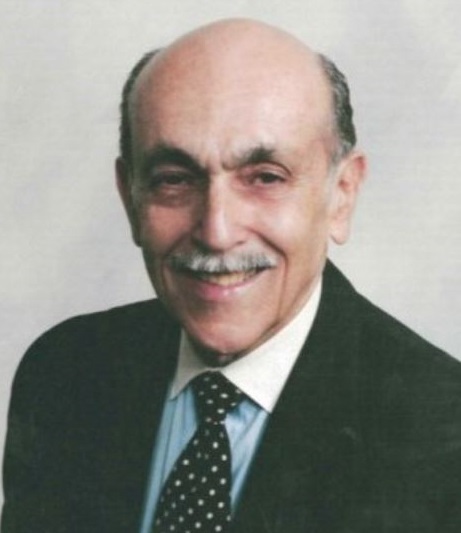
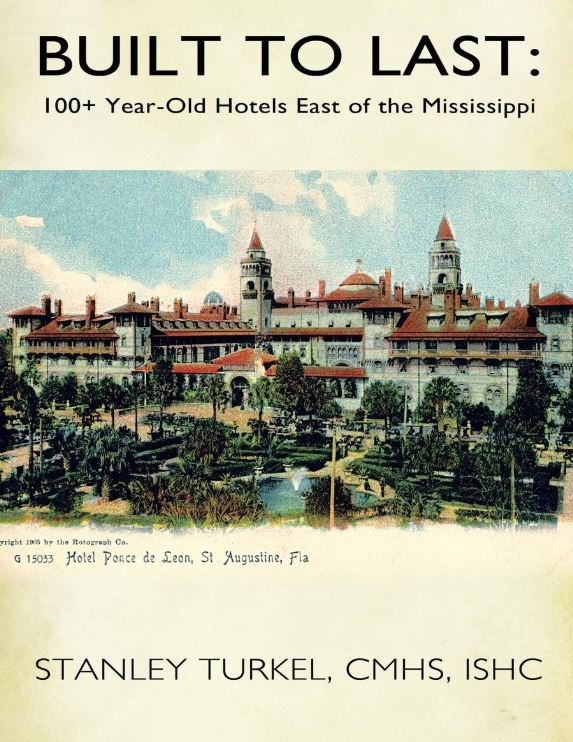
Guest Historian Series
Read Guest Historian SeriesNobody Asked Me, But… No.256;
Hotel History: Hotel Severin, Indianapolis, Indiana (1913)
By Stanley Turkel, CMHS
The original Hotel Severin opened in 1913 when it replaced the Grand Hotel of Indianapolis. Its location directly across Jackson Place from the Union Station made it the favorite hotel for passengers on the 300 daily trains. It was built by Henry Severin, Jr., the heir to a wholesale grocery fortune, with help from real estate developers Carl Graham Fisher and James A. Allison, who had built the famed Indianapolis Motor Speedway. The hotel was designed by Vonnegut and Bohn, an architectural firm active in early to mid-twentieth- century Indianapolis. When Bernard Vonnegut, Sr. died in 1908, he was succeeded by his son Kurt Vonnegut, Sr. who later became the father of Kurt Vonnegut, Jr., the famous novelist.
The Grand Hotel was built in 1876 and, at one point, was owned by Thomas Taggart who subsequently owned the French Lick Springs Hotel. Taggart later served as Mayor of Indianapolis and U.S. Senator from Indiana.
On February 19, 1905, a fire which started in the large wholesale millinery house of Fahnley & McCrea, spread to eight adjoining buildings including the Grand Hotel, then the largest hotel in Indiana. Within forty-five minutes, eight buildings in the threatened district had been totally destroyed. Although the losses were placed at $1.1 million, the Grand Hotel was luckily saved from extensive damage.
The Severin Hotel occupies an imposing position in the Wholesale District skyline overlooking Union Station and most of the neighboring hotels. The twelve-story hotel is constructed of a reinforced concrete frame with brick curtain walls. Rectangular in plan, it is eleven bays wide along West Georgia Street and five bays along South Illinois and McCrea Streets. The first two floors are organized into a Renaissance scheme of monumental arch windows. From the third to the twelfth floor, rectangular windows follow a uniform grid pattern.
Several different owners managed the hotel until it was purchased in 1966 by Warren M. Atkinson who named it the Atkinson Hotel. In 1988, the Mansur Development Corporation bought the hotel and, after a $40 million restoration, renamed it the Omni Severin Hotel. During the restoration period, two new twelve-story towers were built and the expanded hotel was connected to the Circle Centre Mall and the convention center.
The original main lobby is located in today’s Severin ballroom. The missing ornate railings above the lobby were found in a barn 30 miles from the hotel and were installed in their original location. The 1913 brass mailbox still serves as a working mailbox to this day. Original solid mahogany guestroom dressers are located on each elevator landing. In the Severin Ballroom, a magnificent Austrian crystal chandelier and a dramatic marble stairway recall the hotel’s lavish history. The Omni Severin Hotel is listed in the National Register of Historic Places and is a member of Historic Hotels of America.
*****
About Stanley Turkel, CMHS
Stanley Turkel is a recognized consultant in the hotel industry. He operates his hotel consulting practice serving as an expert witness in hotel-related cases and providing asset management an and hotel franchising consultation. Prior to forming his hotel consulting firm, Turkel was the Product Line Manager for worldwide Hotel/Motel Operations at the International Telephone & Telegraph Co. overseeing the Sheraton Corporation of America. Before joining IT&T, he was the Resident Manager of the Americana Hotel (1842 Rooms), General Manager of the Drake Hotel (680 Rooms) and General Manager of the Summit Hotel (762 Rooms), all in New York City. He serves as a Friend of the Tisch Center and lectures at the NYU Tisch Center for Hospitality and Tourism. He is certified as a Master Hotel Supplier Emeritus by the Educational Institute of the American Hotel and Lodging Association. He served for eleven years as Chairman of the Board of the Trustees of the City Club of New York and is now the Honorary Chairman.
Stanley Turkel is one of the most widely-published authors in the hospitality field. More than 275 articles on various hotel subjects have been posted in hotel magazines and on the Hotel-Online, Blue MauMau, Hotel News Resource and eTurboNews websites. Two of his hotel books have been promoted, distributed and sold by the American Hotel & Lodging Educational Institute (Great American Hoteliers: Pioneers of the Hotel Industry and Built To Last: 100+ Year-Old Hotels East of the Mississippi). A third hotel book (Built To Last: 100+ Year-Old Hotels in New York) was called "passionate and informative" by the New York Times. Executive Vice President of Historic Hotels of America, Lawrence Horwitz, has even praised one book, Great American Hoteliers Volume 2: Pioneers of the Hotel Industry:
- “If you have ever been in a hotel, as a guest, attended a conference, enjoyed a romantic dinner, celebrated a special occasion, or worked as a hotelier in the front or back of the house, Great American Hoteliers, Volume 2: Pioneers of the Hotel Industry is a must read book. This book is recommended for any business person, entrepreneur, student, or aspiring hotelier. This book is an excellent history book with insights into seventeen of the great innovators and visionaries of the hotel industry and their inspirational stories.”
Turkel was designated as the “2014 Historian of the Year by Historic Hotels of America,” the official program of the National Trust for Historic Preservation. This award is presented to an individual for making a unique contribution in the research and presentation of history and whose work has encouraged a wide discussion, greater understanding and enthusiasm for American History.
Works published by Stanley Turkel include:
- Heroes of the American Reconstruction (2005)
- Great American Hoteliers: Pioneers of the Hotel Industry (2009)
- Built to Last: 100+ Year-Old Hotels in New York (2011)
- Built to Last: 100+ Year-Old Hotels East of the Mississippi (2013)
- Hotel Mavens: Lucius M. Boomer, George C. Boldt and Oscar of the Waldorf (2014)
- Great American Hoteliers Volume 2: Pioneers of the Hotel Industry (2016)
- Built to Last: 100+ Year-Old Hotels West of the Mississippi (2017)
- Hotel Mavens Volume 2: Henry Morrison Flagler, Henry Bradley Plant, Carl Graham Fisher (2018)
- Great American Hotel Architects Volume 1 (2019)
- Hotel Mavens Volume 3: Bob and Larry Tisch, Curt Strand, Ralph Hitz, Cesar Ritz, Raymond Orteig (2020)
Most of these books can be ordered from AuthorHouse—(except Heroes of the American Reconstruction, which can be ordered from McFarland)—by visiting www.stanleyturkel.com, or by clicking on the book’s title.
Contact: Stanley Turkel
stanturkel@aol.com/917-628-8549






















